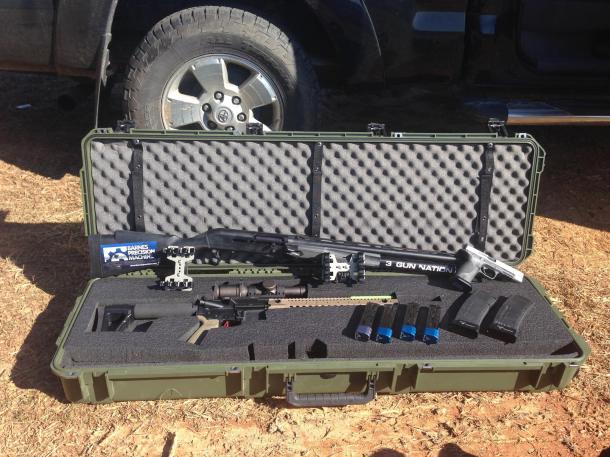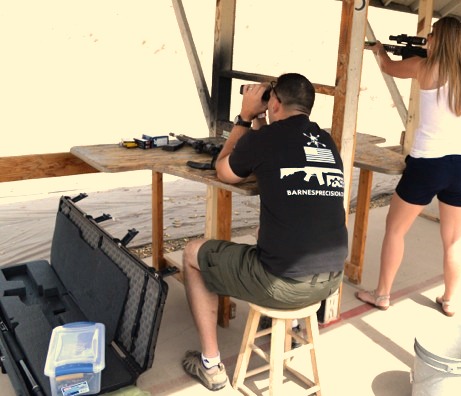
Waltzing up into an airport with multiple firearms in large rifle cases can be an unnerving experience, especially for a first timer. In fact, flying anywhere, anytime with just a carry-on bag can be frustrating. So, how do we make a seemingly nerve-racking experience into a simple, mostly hassle-free experience? Preparation and planning are the key. I am not an airline professional, nor am I a professional at airline travel. I do, however, have a lot of experience flying with firearms and have learned some things along the way. For some odd reason people seem to overcomplicate this. This little “how to” is applicable to any scenario where you have to fly with ammo and firearms, such as a hunting trip, training or competition. Since it is the most firearm heavy I will focus on competitive shooting and, more specifically, 3 gun.
The time leading up to your competition is very important, you must plan ahead! Equipment needed includes:
- A lockable, secure, hard case with proper foam insulation to protect your firearms.
- Plastic ammo can/plastic tub (anything to keep your ammo boxes and gear/spare parts from floating around your luggage)
- NON-TSA Locks (sturdy, that will fit into the holes on your hard case)
- TSA Locks
- Permanent Marker
- Scotch Tape
- Scale
- Measuring Tape
- Ammo Boxes (that separate the ammo cartridges, or original packaging)
- Patience
Step #1
Do everything in advance, literally. Two weeks before your event do a trial run. Pack everything, and weigh it all before so you know what you can bring and what you may need to leave or ship. Follow this link and read the TSA rules carefully: http://www.tsa.gov/traveler-information/firearms-and-ammunition
Now that you have educated yourself on the TSA guidelines, we can proceed.
Make sure you know exactly how much ammunition you plan to bring and exactly when you are arriving at your competition. If you are shooting a 3 Gun match, the ammunition required will most likely be much more than the standard of 11lbs. maximum per passenger. Whatever ammunition you have in excess of 11lbs. will need to be shipped via UPS ground. Look up your local UPS Customer Service Center and ship the ammunition to your hotel or competitive shooting location. Whatever your choice, call the location and make sure that they will accept your package and store it for safekeeping. It can take several days for your ammunition to arrive via ground transport, so make sure to ask when your shipment will arrive and plan accordingly.
Many airlines vary in their rules about ammunition and how it can be transported. To stay in the clear, follow the TSA guidelines and check the regulations of the airlines you are flying.
Now that you have your 11lbs. or less of ammo, make sure it is sealed either in its original packaging or an appropriate container designed for small arms ammunition. If you reload your own ammo, you can find some original ammunition boxes similar to what you have loaded and pack it inside of those. Use a scale and make sure that your ammo is not over 11lbs., and probably an ounce or so under to account for variances in scale accuracy. Do not, I repeat, do not try to cheat the system. The repercussions can be expensive and make your travel more of a headache than it needs to be.
Once your ammo is packaged, seal it all up in a small box, tub or plastic ammo can so that it does not float around your checked bag. This also makes it easy to show the attendant at check in. Not all, but some will ask you to take the ammo out so they can see it and then have you weigh it on the scale. Now….moving on to your gun case.
Step #2
I highly encourage you to purchase a quality hard case with customizable quality foam inserts. It will protect your investment from the rough handling it is about to receive from the airlines. When you arrive at your destination, you want your gear to be in the same shape that it left in, and you definitely want your zero to be intact! Don’t be cheap when it comes to protecting your guns, gear and optics. A quality hard case should have the ability to be locked shut in several locations with heavy duty locks. TSA regulation states that you must carry your guns in a locked, hard sided case that cannot be pried open by hand. There are lots of great cases out there and companies that will customize the foam interior to custom fit your firearms. The case I use is Patriot Case’s Ultimate 3 Gun Kit, which is 56” x 16” x 8”, which totals 80 inches. Most airlines consider anything over 62 inches to be oversized, so call your airlines. Most airlines will count it as sporting equipment and not charge any fee. I have never been charged using Southwest or Jet Blue. Additionally, they have provisions/exceptions for military and the lowest oversize baggage fees should they decide to charge you. If there is any confusion with your local airline, take your empty gun case to the airport and ask them.
Now that we have that clear, make sure that your gun case (with all the guns, mags, gear, etc.) is under 50lbs. Some airlines will let you slide with the dimensions, but never with weight unless you have an active duty military ID. Even some still require a set of orders in addition to ID. If it is overweight, try putting some of your gear in your checked bag. I always take my eye protection, ear pro and belt in my carry-on so I don’t have to worry about it getting crushed. Some recommend putting band stickers, and other non-firearms related stickers, on your case. Let’s be honest guys, you’re not fooling anyone, we all know what is in there. I keep mine blank with the label and my name stuck on it for easy identification.
Step #3
Label your locks and the matching keys with a Sharpie marker! This will save you so much time and hassle! Label them however you want, 1-2-3-4-5, A1-A2, and so on. Just keep it basic and keep it labeled. Make sure you have two sets of labeled keys. If you have a travel buddy, swap backup keys so that if you lose yours, you’re not out of luck! Keep all your keys together and in an easily accessible location as you will have to access them quickly when you are at the airport. I use a zip lock baggie in my front pocket. Use a TSA lock on your checked bag with the ammo and whatever other miscellaneous gear you have in it. Seriously, that should go without being said.
Step #4
The trial run is over; you have all your gear packed and locks ready. You are good to go! Arrive at the airport no less than two hours in advance. Make sure you have your print out of TSA and Airline regulations pertaining to firearms (seriously, you might have to educated someone). When you approach the ticket counter tell them you need to declare UNLOADED firearms. They should have you fill out a small ticket with you name, address and telephone number. You will sign it declaring the firearms are unloaded then place it into the container. Once it is inside the container lock it completely and follow instructions from the airline employee. Depending on the airport, you will either take you tagged bag to the TSA agent yourself, someone will escort you with the bag to TSA, or you will simply wait while your locked bag is screened by the TSA. Once it is through security, you will be notified and you can board your flight with confidence that it will arrive safely at your destination. Lastly, be sure to keep your bag tags provided by the airline in order to claim your firearm at your destination. It will most likely come through the oversize baggage section at baggage claim where the airport should check your ID and tags.
Now that you know how to travel with firearms, I hope your next flight goes smoothly. Safe travels!




